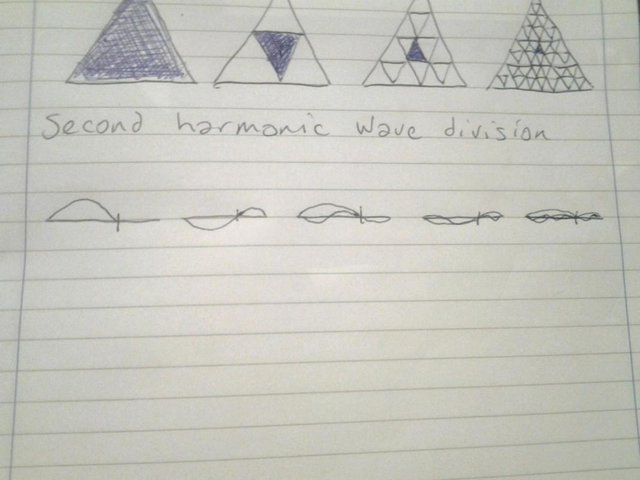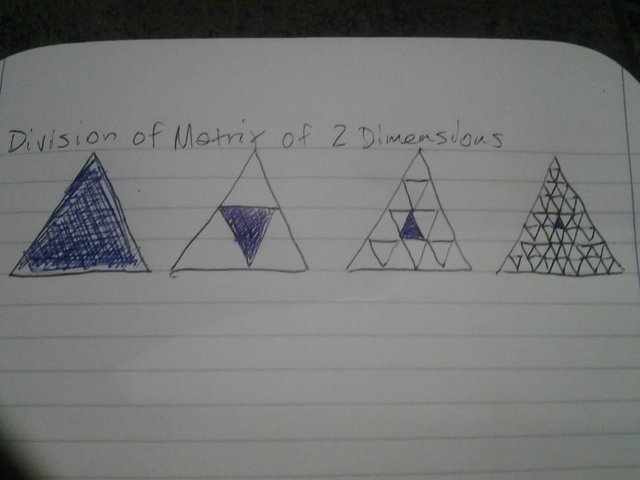Part 3 of my series on the Spacetime Expansion Hypothesis
I just want to make commentary on this one. As I was reading through it, my brain filled with so many images and it was hard to follow the text. This is an example of my writing when I am intensely visualising. I think the next one is a bit more stodgy but I hope you enjoy it anyway. Just bear in mind I typed this out while living on the street on a 4 year old samsung smartphone (xcover).
For the previous: Part 1 Part 2
2016-04-18.13:40


In the photograph is a diagram of a 2 dimensional division matrix. The static particle in the centre shrinks away with each division cycle. But the geometry between inert particles like protons and neutrons is 'knitted' into a stable relation by electrons.
I have not touched on the mechanism of this yet so I will explain. In the physics of stringed instruments there is a way to create resonance. By tamping but not closing the string at 1/3 of its length you create what is called a second harmonic. This has a sharp ringing sound and is caused by the wave partially reflecting across the tamping point.
The energy travels across this boundary and the longer side has a partial frequency of oscillation at a base carrier wave, and the smaller part resonates at double this frequency, and due to the coherence between octaves, this is the first resonant frequency, two such waves then transfer to the longer side, and this repeats until the string is unable to carry the higher frequency at the end of many cycles, although for human ears this drops off after no more than 22khz, which is about 8 or 9 octaves.
This produces a division cycle. Each time the oscillation crosses the tamping point is a new cycle of half the period of the first. At some point I decided that this was the fundamental geometry of the surface of spacetime. Our universe thus is a figure 8. With this resonance geometry, we can see the advancing front of the wave, which I am saying is the present moment, we see in a linear form the division cycle pictures in the first diagram.
I considered the idea that perhaps there is more than one harmonic mirror point, and I am not entirely certain yet that there is not. Other refraction points would generate secondary waveforms overlaid that would, after maybe 5 harmonic refractors account for the stochastic behaviour of spacetime. 1st haromonic is just one equal refractor, second is at 1/3, third at 1/4, fourth at 1/5th and fifth at 1/6th. For the sake of starting somewhere, let us say that the universe we see is the 2/3 section and the other 5 subunits are mirror universes. They all are the same displaced by time and a subsequent harmonic frequency up the octave.
I have trouble going much further pondering such a harmonic construct because the numbers grow geometrically. I will thus settle on the three dimensional space being refracted only at the second harmonic, and assert a second set of three dimensions that are waveforms that cause twist. I will call these "time" as they cause change. A dividing matrix of a second harmonic gives us the stable matrix that in three dimensions produces the dividing tetrahedral matrix. This then is the primary Principle, and the overlaid twist of the time dimension pairs is where the stochastic element is added.
However, there is still an overall symmetry, this symmetry has the form of a toroid. When the division occurs, each new composite wave splits into 5 new toroids, and each one has a pole of rotation, as well as a component of rate. These rotations split into these higher harmonics, perhaps the higher dimensions are multiple, with each subsequent being 3rd, 4th, 5th and 6th harmonics.
Such an arrangement allows the mechanism of the emergence of stochastic patterns created by vibrational superposition, and rapidly mostly produce overall balanced but unstable patterns and a very small proportion remain orderly. According to current knowledge and well established by the time I was studying Physics and Chemistry in school, it was known that the universe is mostly space, matter only occupies a very small portion, perhaps billionths or smaller. (probably squillionths, 10^20 or more)
Such a model of spacetime has a very simple and elegant structure typical of fractal geometries. 5 fundamental resonant systems overlaid produces the full spectrum of any oscillating phenomena we know of, and explains why space predominates. Space is disordered, and matter is tiny little pieces of order swimming in the noise. The harmonious and disharmonious repel each other, thus producing the pressure I talk about.
So where next?
I have over the years produced probably now millions of words trying to apprehend the fundamental principles, there is many areas I have explored, iterated, and mostly discarded eventually. What I am working towards here is to accelerate this process by spending more of my time on this to tease out what works and accumulate it into a body of theory.
The two immediate next subjects are the overall model of gravitational attraction and the mechanism of pressure dispersion that allows relatively stable structure, the surface tension equilibrium.
I will start with the latter because I have a concrete and well developed general concept. The former is the details of how the equilibrium actually occurs. It leads to the mechanisms that may allow the charming of electrons and photons to move catalytically. But you must first understand the general mechanism.
The simplest way to explain it is with the Convergence phenomena I have already described a little and made a diagram. Liquids are the simplest model to understand.
Liquids, as I discussed before, are matter in a state where they can form flexible surfaces. They possess mostly only bonds along one axis with a smaller set with three poles, visually a net described it. The most stable is composed entirely of particles with three bonding axes, and the paragon of this geometry was discovered by Buckminster Fuller, and is illustrated in the shape of the football with pentagons surrounded by hexagons.
Liquids however mostly have flexible strings of two bonding points like a chain. These links are flexible and allow dissolution and combining of mass. In the absence of strong gravity, liquids form a spherical shape. Why a sphere? Because the surface is like a fabric, a thin layer of one molecule or atom thickness, inside there is a mixture of more of these fabric surfaces and gases. The distribution is gaussian. The surface is like a bag and the higher energy, in principle usually only considered on the basis of the infrared photon density, is a structure destroying force.
The surface thus is energy limited, or more precisely, composed of these two and three bond particles (I will use particle as shorthand for both atomic and molecular liquids) and being in limited supply dictated by the level of density of bond dissolving infrared photons, and thus the form must be most optimal, the minimum required to trap the energy inside.
Geometrically it will resemble a geodesic pattern, with some links being flexible two bond particles, which give the liquid the flexibility we know it has. The surface thus is primarily held together by the three bond particles, who must sit at the edge of the bag of liquid matter in sufficient density.
Evaporation is obviously the escape of higher energy gas phase particles through the longer chains of interstitial two bond particles parting and allowing the exit of the energetic unbonded gas particles.
So what is the criteria that allows this liquid state - it is spherical distribution, a sphere is the geometry with the lowest ratio of volume to surface, ie per volume, the least amount of these surface enabling three bond particles is required to maintain coherence of the matter.
When two bodies of liquid come into contact, their surface merges. The energetic contents of these two bags thus become a single continuous volume. Thus the surface will have to re-optimise. But why do the drops then merge into a new sphere?
Because a bigger volume has a lower surface to volume ratio than two spheres. The relationship is a factor of the inverse cube of the volumes. The volume is summative, but the surface is exponential. The expansion forces within the drop focus from a new combined mass center, the surfaces can still then be maintained by a smaller percentage of the combined mass and the unneeded triple bond particles move inside the surface and the new unified mass holds more substance with a lower pressure pushing at the surface.
This principle applies, however also to gases. In the absence of gravity, a body of gas forms a stochastic, gaussian distributed soft edged sphere with the lowest density of infrared photons int he centre, and highest at the edges, rising by the inverse square ratio from the centre. Likewise, two blobs of gas will redistribute into a new, combined gas blob the same way. However, this is where we start to see something resembling very closely the behaviour we call gravity. In fact, in outer space, where we see such gas clouds, over time the most thermally stable inter-particle bond materials accumulate in the center, and from this process eventually stars and planets form.
So, I have elaborated upon the mechanism of surface optimisation, and the thermal gradient within bodies of mass tends towards higher heat at the edge and lower heat at the edges, which may or may not have a surface, which is a thin layer of a flexible solid web of matter held together by three (or more) bonding particles.
Now I can move along to the general principle of gravity, which I am asserting is caused by this same pattern. Solid, or indeed liquid or gaseous matter, is not just neutrons and protons. Swimming between the gaps, very big gaps, between are electrons and photons. These particles are somewhat akin to the gas particles in that they do not form bonds, but rather geometric relationships between themselves and the atomic nuclei.

We can't stop here! This is Whale country!
Loki was born in Australia, now lives in Sofia, Bulgaria. IT generalist, physics theorist, futurist and cyber-agorist. Loki's life mission is to establish a secure, distributed layer atop the internet, and enable space migration.
I'm a thoughtocaster, a conundrummer in a band called Life Puzzler. I've flipped more lids than a monkey in a soup kitchen, of the mind. - Xavier, Renegade Angel